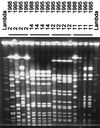Follow-up of Staphylococcus aureus nasal carriage after 8 years: redefining the persistent carrier state
- PMID: 10488166
- PMCID: PMC85511
- DOI: 10.1128/JCM.37.10.3133-3140.1999
Follow-up of Staphylococcus aureus nasal carriage after 8 years: redefining the persistent carrier state
Abstract
Studies of Staphylococcus aureus nasal carriage have distinguished three carriage patterns: persistent, intermittent, and noncarriage. The criteria used to identify these carriage patterns have been inconsistent. In 1988 the S. aureus nasal carrier index, i.e., the proportion of nasal swab specimen cultures yielding S. aureus, was determined for 91 staff members of various departments of a large university hospital by obtaining weekly nasal swab specimens for culture over a 12-week period. Thirty-three (36%) persons had carrier indices of 0.80 or higher, 15 (17%) had indices between 0.1 and 0.7, and 43 (47%) had indices of zero. In 1995, 17 individuals with carrier indices of 0.80 or higher in 1988 were available for reexamination. For 12 (71%) of these individuals, S. aureus was again isolated from a single nasal swab, i.e., from each individual with a 1988 carrier index of 1.0 but from only half of those with indices below 1.0. Genotyping (by randomly amplified polymorphic DNA analysis and pulsed-field gel electrophoresis) of all S. aureus strains showed that strains isolated from only three individuals, all with 1988 carrier indices of 1.0, in 1988 and 1995 showed genetic similarity. In conclusion, persistent S. aureus nasal carriage is a unique characteristic of a fraction of the population, and the attribute "persistent" should be confined to those individuals for whom serial nasal swab specimen cultures consistently yield S. aureus.
Figures





Similar articles
-
Nasal carriage of staphylococcus aureus and epidemiology of surgical-site infections in a Sudanese university hospital.J Clin Microbiol. 1998 Dec;36(12):3614-8. doi: 10.1128/JCM.36.12.3614-3618.1998. J Clin Microbiol. 1998. PMID: 9817883 Free PMC article.
-
Typing of Staphylococcus aureus colonising human nasal carriers by pulsed-field gel electrophoresis.J Med Microbiol. 1995 Feb;42(2):127-32. doi: 10.1099/00222615-42-2-127. J Med Microbiol. 1995. PMID: 7869348
-
Host-microbe interplay in persistent Staphylococcus aureus nasal carriage in HIV patients.Microbes Infect. 2008 Feb;10(2):151-8. doi: 10.1016/j.micinf.2007.10.017. Epub 2007 Nov 9. Microbes Infect. 2008. PMID: 18248760
-
What determines nasal carriage of Staphylococcus aureus?Trends Microbiol. 2001 Dec;9(12):605-10. doi: 10.1016/s0966-842x(01)02254-5. Trends Microbiol. 2001. PMID: 11728874 Review.
-
New approaches to reduce Staphylococcus aureus nosocomial infection rates: treating S. aureus nasal carriage.Ann Pharmacother. 1998 Jan;32(1):S7-16. doi: 10.1177/106002809803200104. Ann Pharmacother. 1998. PMID: 9475834 Review.
Cited by
-
New acquisition of antibiotic-resistant organisms in skilled nursing facilities.J Clin Microbiol. 2012 May;50(5):1698-703. doi: 10.1128/JCM.06469-11. Epub 2012 Feb 29. J Clin Microbiol. 2012. PMID: 22378900 Free PMC article.
-
Human factor in Staphylococcus aureus nasal carriage.Infect Immun. 2004 Nov;72(11):6685-8. doi: 10.1128/IAI.72.11.6685-6688.2004. Infect Immun. 2004. PMID: 15501803 Free PMC article.
-
Genome-Wide Association Study of Staphylococcus aureus Carriage in a Community-Based Sample of Mexican-Americans in Starr County, Texas.PLoS One. 2015 Nov 16;10(11):e0142130. doi: 10.1371/journal.pone.0142130. eCollection 2015. PLoS One. 2015. PMID: 26569114 Free PMC article.
-
Identifying Hemodialysis Patients With the Highest Risk of Staphylococcus aureus Endogenous Infection Through a Simple Nasal Sampling Algorithm.Medicine (Baltimore). 2016 Apr;95(14):e3231. doi: 10.1097/MD.0000000000003231. Medicine (Baltimore). 2016. PMID: 27057858 Free PMC article.
-
MRSA nasal colonization burden and risk of MRSA infection.Am J Infect Control. 2013 May;41(5):405-10. doi: 10.1016/j.ajic.2012.07.017. Epub 2012 Dec 20. Am J Infect Control. 2013. PMID: 23261345 Free PMC article.
References
-
- Armstrong-Esther C A, Smith J E. Carriage patterns of Staphylococcus aureus in a healthy non-hospital population of adults and children. Ann Hum Biol. 1976;3:221–227. - PubMed
-
- Bruun J N. Post-operative wound infection. Predisposing factors and the effect of a reduction in the dissemination of staphylococci. Acta Med Scand. 1970;514:1–89. - PubMed
MeSH terms
LinkOut - more resources
Full Text Sources
Other Literature Sources
Medical

